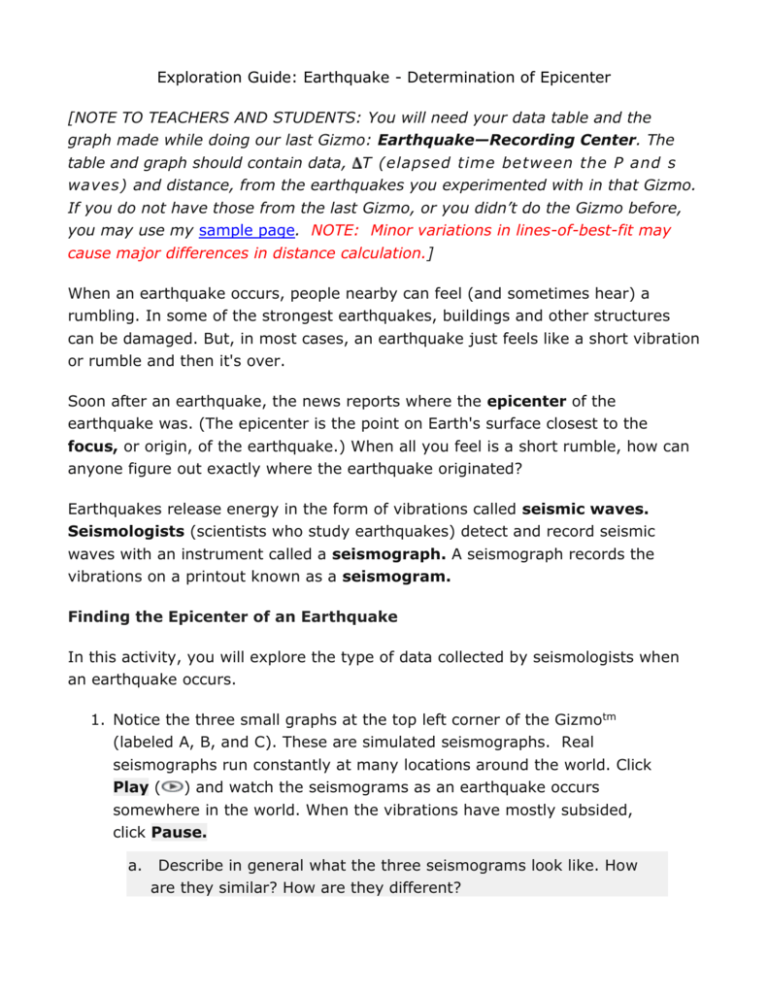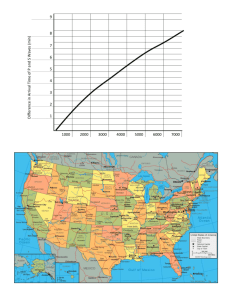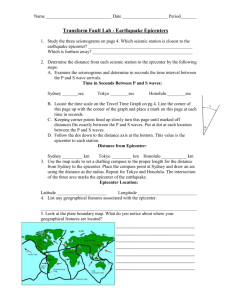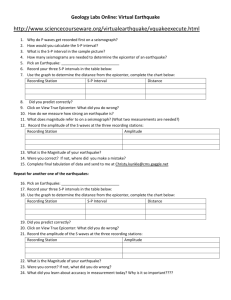Exploration Guide: Earthquake
advertisement

Exploration Guide: Earthquake - Determination of Epicenter [NOTE TO TEACHERS AND STUDENTS: You will need your data table and the graph made while doing our last Gizmo: Earthquake—Recording Center. The table and graph should contain data, T (elapsed time between the P and s waves) and distance, from the earthquakes you experimented with in that Gizmo. If you do not have those from the last Gizmo, or you didn’t do the Gizmo before, you may use my sample page. NOTE: Minor variations in lines-of-best-fit may cause major differences in distance calculation.] When an earthquake occurs, people nearby can feel (and sometimes hear) a rumbling. In some of the strongest earthquakes, buildings and other structures can be damaged. But, in most cases, an earthquake just feels like a short vibration or rumble and then it's over. Soon after an earthquake, the news reports where the epicenter of the earthquake was. (The epicenter is the point on Earth's surface closest to the focus, or origin, of the earthquake.) When all you feel is a short rumble, how can anyone figure out exactly where the earthquake originated? Earthquakes release energy in the form of vibrations called seismic waves. Seismologists (scientists who study earthquakes) detect and record seismic waves with an instrument called a seismograph. A seismograph records the vibrations on a printout known as a seismogram. Finding the Epicenter of an Earthquake In this activity, you will explore the type of data collected by seismologists when an earthquake occurs. 1. Notice the three small graphs at the top left corner of the Gizmotm (labeled A, B, and C). These are simulated seismographs. Real seismographs run constantly at many locations around the world. Click Play ( ) and watch the seismograms as an earthquake occurs somewhere in the world. When the vibrations have mostly subsided, click Pause. a. Describe in general what the three seismograms look like. How are they similar? How are they different? b. When an earthquake occurs, it sends out fast-moving P waves and slower-moving S waves. P waves cause a fairly small vibration. S waves are much stronger and cause taller "spikes" in the seismogram. The amount of time between the arrival of the first P wave and the arrival of the first S wave is called T. (Note: Each recording station will have a different value for T.) To find T, click on Show time probe. Drag one of the vertical probes and place it on the first seismogram where the first P wave arrived. Then place the second probe where the first S wave arrived. What is T for Recording station A? What is T for Recording Station B? For Recording station C? c. The larger the value of T, the further that recording station was from the epicenter. Of the three recording stations in the Gizmo, which one was closest to the epicenter? Which was furthest? 2. Next you will use your data table and graph (from our last Gizmo), along with the values for T that you just calculated, to determine how far each recording station was from the epicenter. a. What was the value of T that you found for Recording station A? Based on that, use your data table and graph to determine how far Recording station A was from the epicenter. (Make your best estimate, based on how this value for T fits in with your previous data.) What was the distance? b. In the Gizmo, select Show station A. Set the Radius slider to the distance from the epicenter. You will see a circle around Recording station A. A circle shows all the points that are the same distance from the center. In this case, the circle shows all the points that are the correct distance from Recording station A. According to your calculations, the epicenter lies somewhere on that circle. c. Repeat the process for Recording station B and Recording station C. What distances did you find for each? d. Once you have all three radii set, the three circles shown in the Gizmo should intersect at one point. That point is the epicenter of the earthquake. If you have found the correct epicenter you will see a red symbol like the one shown below. (A small red dot will appear if the three circles intersect at a point that is not the epicenter.) [NOTE: Due to variations in your graphs and the lines of best fit, you may NOT end up finding the epicenter expected by the GIZMO. If your data results in the three circles intersecting, EVEN if you get the red dot and not the bulls-eye symbol, you have read your graph correctly.] e. You should have found that Recording station A was about 430 km from the epicenter, Recording station B was about 800 km from the epicenter, and Recording station C was about 400 km from the epicenter. If you have not already seen this in the Gizmo, adjust the Radius slider settings to see the epicenter. NOTE: If you pressed reset since the start of the GIZMO, these three answers may be very different for you! That is OK! 3. Click Reset. Then click Play and watch as a new earthquake happens somewhere else in the world. Repeat the same process to find the three values for T, calculate the three distances from the epicenter, and then locate the epicenter. (You should do at least three earthquakes, finding the epicenter for each of the three earthquakes.) When you feel you have practiced enough, you may go on to answer the five questions at the bottom of the Gizmo.







